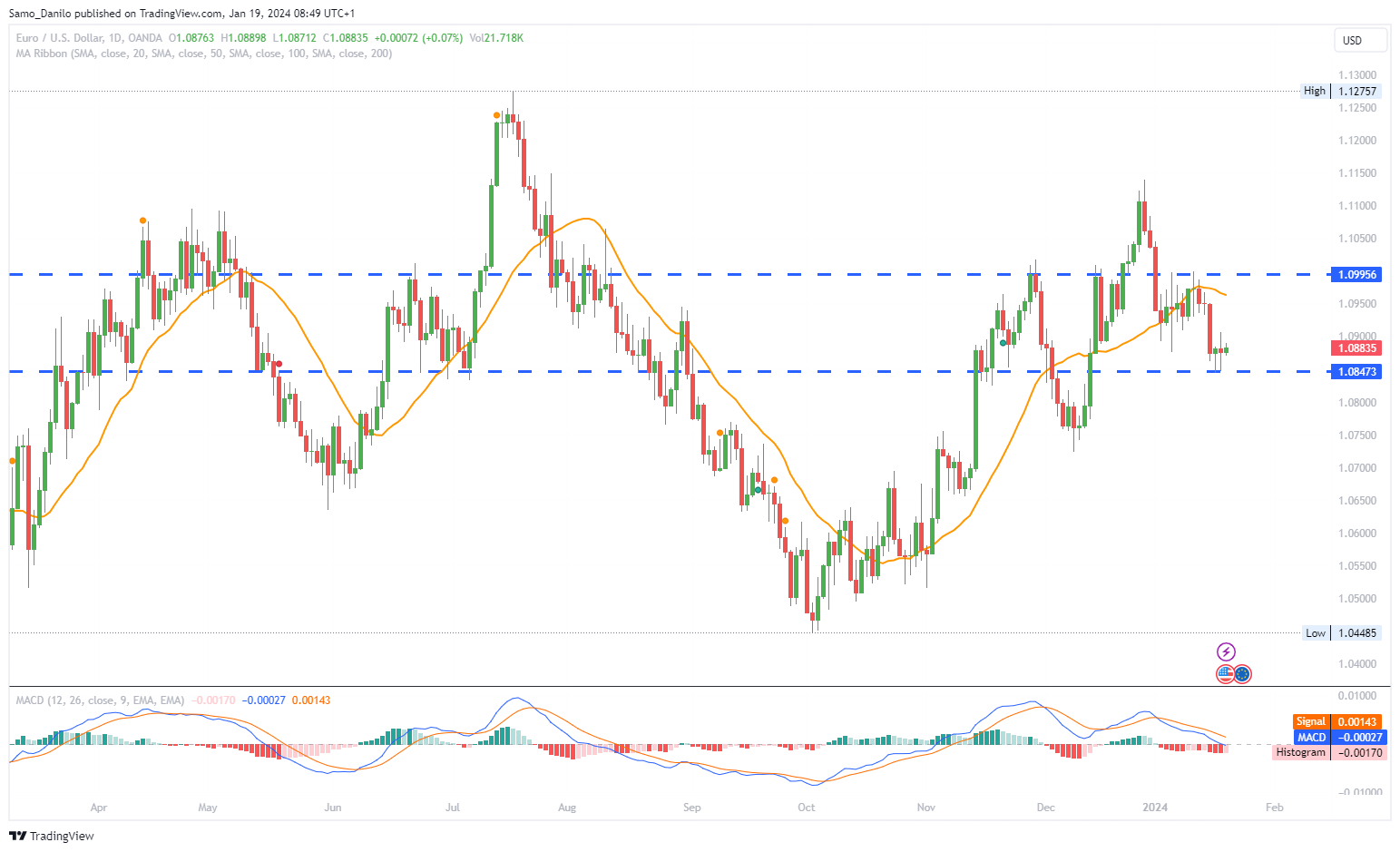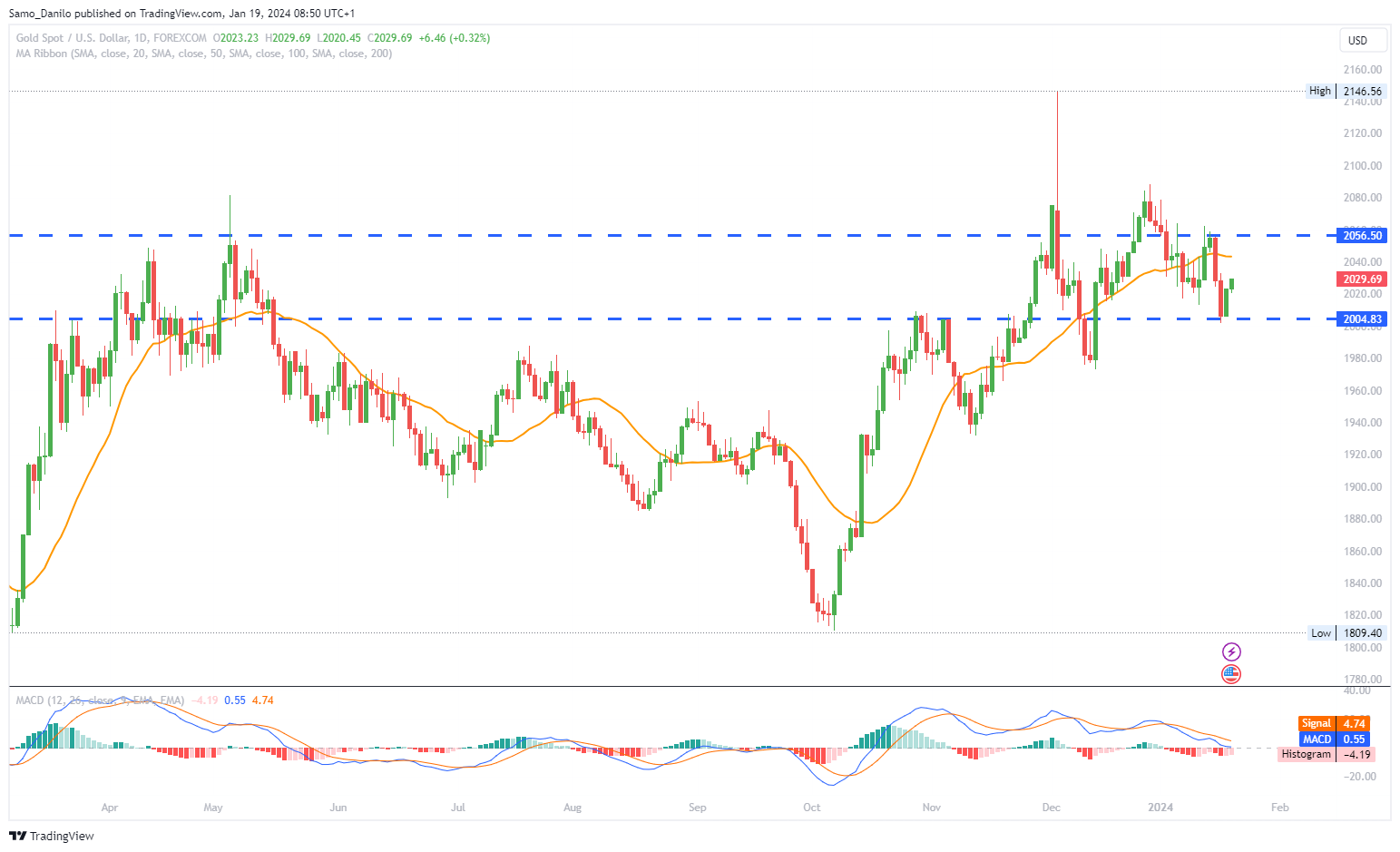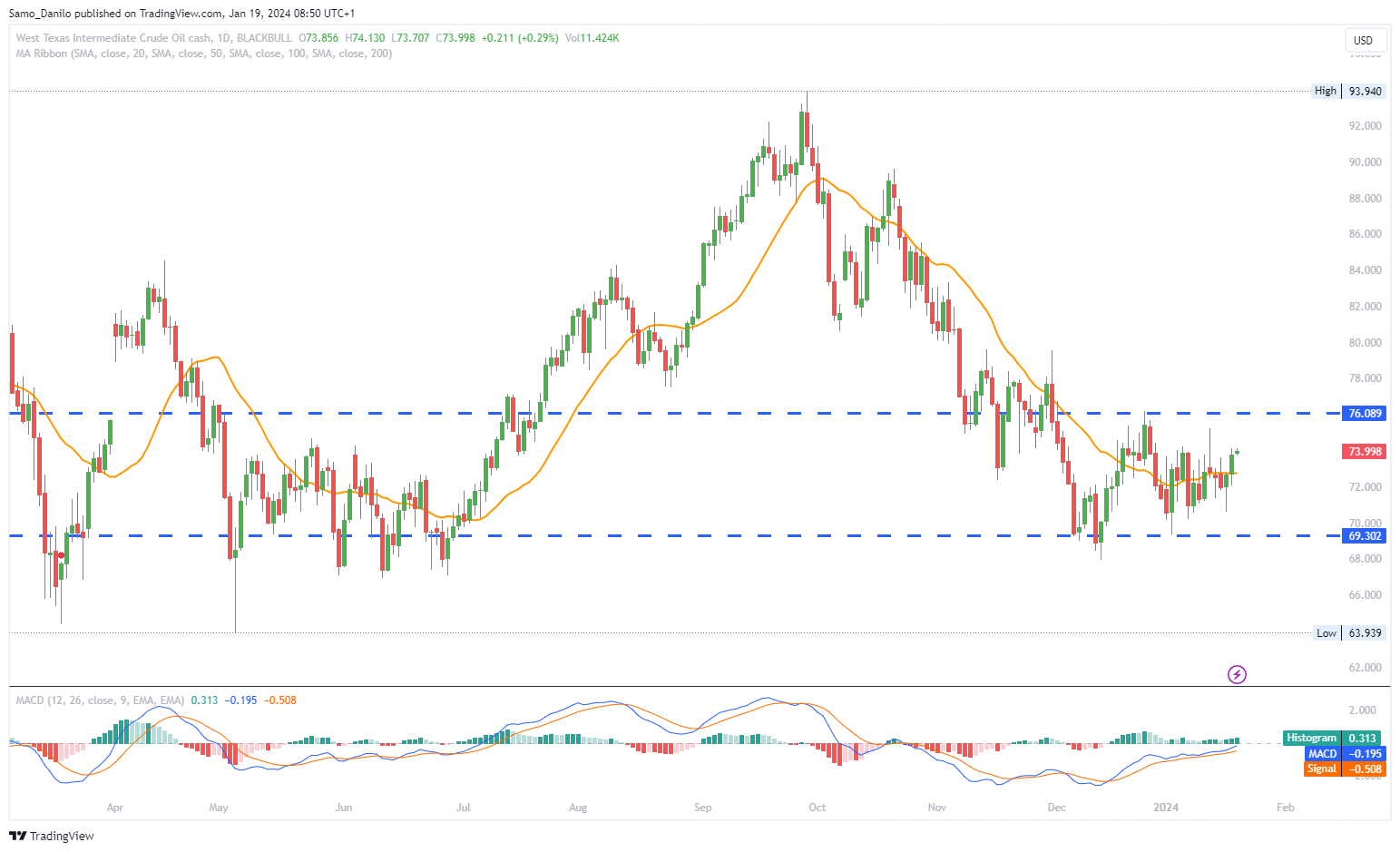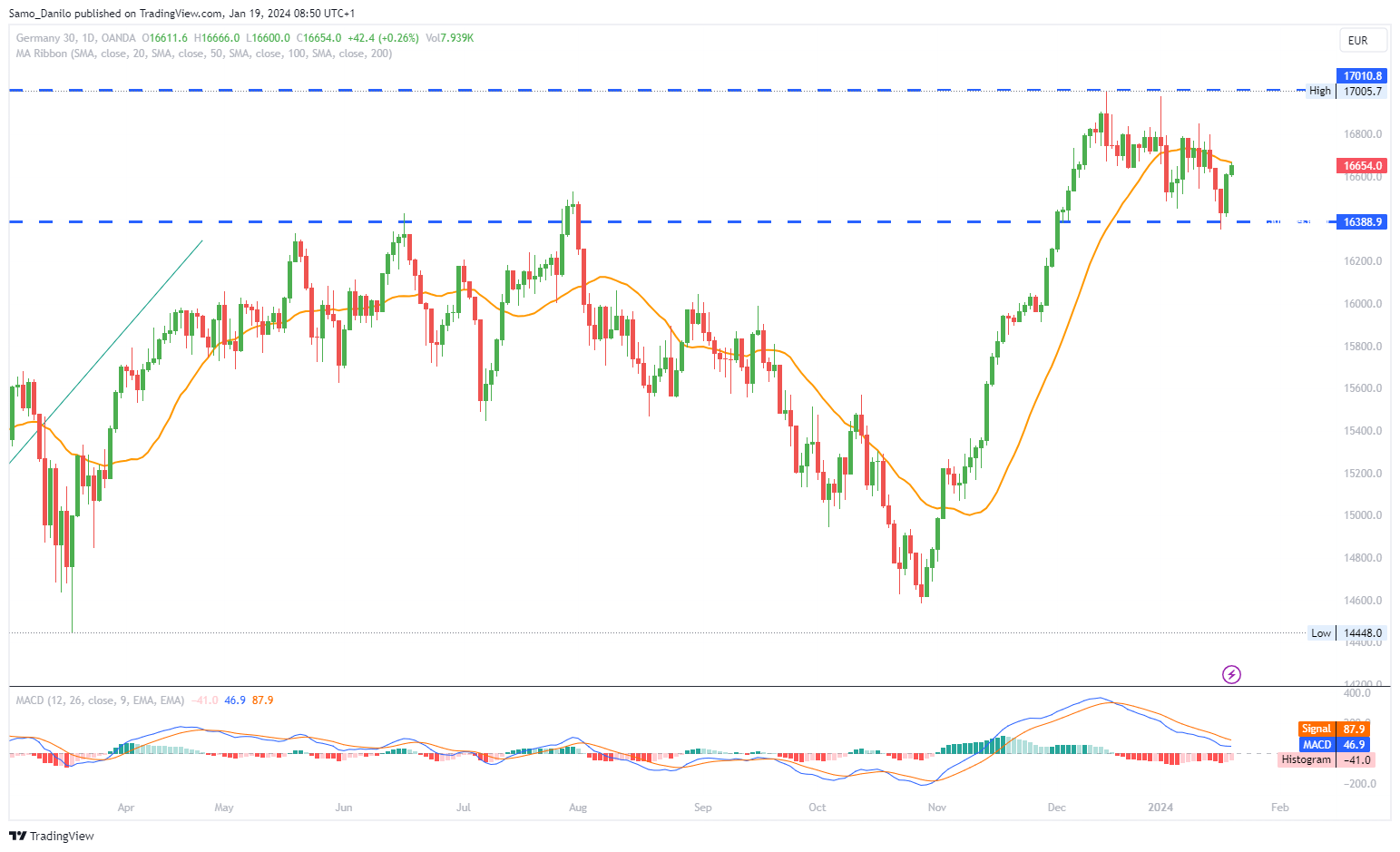EURUSD
- The EUR/USD exhibits an upward movement, recuperating from losses recorded in the previous session. The pair is trading higher around 1.0890 on Friday, signaling a potential rebound.
- The Euro faces challenges from speculations regarding potential rate cuts by the European Central Bank (ECB) in September. ECB President Christine Lagarde had suggested the possibility of a rate reduction in the summer, contributing to uncertainties around the Euro.
- The dollar's uptrend persists, supported by robust readings from the US labor market's weekly results and a healthy rebound in the Philly Fed Manufacturing Index. The USD Index (DXY) maintains a bullish stance, contributing to the Euro's challenges.
- The continuation of the dollar's strength is further supported by comments from Raphael Bostic (Atlanta), a Federal Reserve official. Bostic expressed a willingness to initiate rate cuts before July if there is "convincing" evidence of inflation slowing down more rapidly than expected.
- The overall strength of the dollar, influenced by robust economic indicators and comments from Fed officials, adds pressure on EUR/USD. Investors are closely monitoring these dynamics for insights into the future direction of the currency pair.
Closing statement: In summary, the EUR/USD is experiencing a recovery, but challenges arise from ECB rate cut speculations. The dollar's persistent uptrend, supported by strong economic indicators and Fed comments, continues to impact the currency pair.
GBPUSD
- GBP/USD is witnessing a drop towards 1.2650, driven by intense selling pressure after the UK Retail Sales data for December revealed a more significant decline than expected. This has prompted a bearish sentiment for the pair.
- From a technical standpoint, GBP/USD remains above the lower limit of the ascending regression channel. The Relative Strength Index (RSI) indicator moves sideways above 50, indicating a bullish bias in the near term despite the recent selling pressure.
- Official data from the Office for National Statistics (ONS) reports a substantial decline in UK Retail Sales, tumbling 3.2% over the month in December. This figure is worse than the expected -0.5% and the 1.4% recorded in November.
- Traders have scaled back their expectations for Bank of England (BoE) rate cuts. Previously pricing in an 80% likelihood of a 25 basis points cut by the BoE in May, these odds have now been adjusted to 50%, reflecting the market's reassessment of monetary policy expectations.
- The next significant release for GBP/USD is anticipated on Friday, with the preliminary University of Michigan (UoM) Consumer Sentiment and Inflation Expectations data.
| SMA (20) | Slightly Rising |
| |
| RSI (14) | Slightly Falling |
| |
| MACD (12, 26, 9) | Falling |
|
|
Closing statement: GBP/USD is facing intense selling pressure following a significant decline in UK Retail Sales. Despite this, technical analysis suggests a bullish bias, and traders are adjusting their expectations for BoE rate cuts. The upcoming UoM Consumer Sentiment data will be a key focus for further market insights.
GOLD
- Gold price (XAU/USD) is facing challenges in capitalizing on the modest recovery gains from the previous day, and it is currently oscillating in a narrow trading range as the European session approaches on Friday.
- There is a struggle in the gold market as investors continue to reduce their bets for an early interest rate cut by the Federal Reserve (Fed). This reduction in rate cut expectations is leading to a further rise in US Treasury bond yields.
- Resilient US macro data released throughout the week has contributed to the reduction in expectations for an early Fed rate cut. The data suggests that the US economy is in good shape, providing the central bank with headroom to maintain higher interest rates for a more extended period.
- The markets swiftly reacted to a robust labor-market report, leading to a shift in expectations. Currently, there is just over a 50% chance of a rate cut at the March FOMC meeting, down from 75% a week ago, indicating a change in sentiment among investors.
- Despite the struggles for gains, the downside for gold seems limited. Geopolitical tensions and concerns about sustained weakness in the economic conditions of China, the world's second-largest economy, are contributing to a level of support for gold.
| SMA (20) | Slightly Rising |
| |
| RSI (14) | Slightly Falling |
| |
| MACD (12, 26, 9) | Falling |
|
|
Closing statement: Gold (XAU/USD) is facing challenges in gaining momentum, with investors reducing bets on a Fed rate cut amid resilient US macro data. The limited downside is attributed to geopolitical tensions and concerns about economic weakness in China.
CRUDE OIL
- West Texas Intermediate (WTI) US Crude Oil prices are struggling to build on a two-day-old uptrend, and they are currently oscillating in a narrow trading band during the Asian session on Friday.
- Both the Organization of the Petroleum Producing Countries (OPEC) and the International Energy Agency (IEA) have forecasted an improvement in global oil demand over the next two years. This positive outlook is contributing to the overall sentiment in the oil market.
- An unexpected drop in US crude inventories is providing support to oil prices. The decline is attributed to a 40% drop in North Dakota's oil output due to extreme cold weather and operational challenges. This unexpected drop helps offset fears of slowing economic growth and acts as a potential tailwind for oil prices.
- Ongoing concerns over disruptions in Middle East supplies are in play as US-led forces continue to clash with the Iran-backed Houthi group in the Red Sea. Geopolitical tensions in the region are contributing to the overall uncertainty in the oil market
- Despite some positive factors, concerns persist about economic weakness. Dismal economic data from the Eurozone and worries about sustained economic weakness in China, the world's largest oil importer, are fueling concerns about sluggish demand for oil.
| SMA (20) | Neutral | ||
| RSI (14) | Slightly Rising |
| |
| MACD (12, 26, 9) | Rising |
|
|
Closing statement: In summary, WTI Crude Oil prices are facing challenges in building a sustained uptrend. Positive global oil demand outlook, unexpected drops in US crude inventories, and geopolitical tensions are countered by concerns about economic weakness in the Eurozone and China, contributing to the overall dynamics in the oil market.
DAX
- On Thursday, the European Central Bank (ECB) monetary policy meeting minutes drew investor interest. Recent comments from ECB President Christine Lagarde, Chief Economist Philip Lane, and other members have collectively reduced bets on a rate cut in the first half of the year (H1 2024).
- The minutes revealed that there were no discussions about rate cuts, aligning with recent ECB speeches that warned markets against prematurely expecting ECB rate cuts. ECB members expressed concerns about the economy, but the absence of rate cut talks had a stabilizing effect.
- Monthly, producer prices in Germany decreased by 1.2% in December 2023, exceeding market expectations and continuing the decline from November's 0.5% fall. This decrease raises considerations about economic conditions in Germany, a crucial factor for the DAX.
- On Thursday, US jobless claims drew investor interest. Initial jobless claims declined from 203k to 187k in the week ending January 13, indicating positive momentum in the US labor market. This data may influence global market sentiment, including the DAX.
- Beyond the economic indicators, investors must closely monitor ECB commentary. ECB President Christine Lagarde and Executive Board member Elizabeth McCaul are scheduled to speak on Friday. Any insights provided in these speeches could influence investor sentiment toward DAX-listed stocks.
| SMA (20) | Slightly Falling |
| |
| RSI (14) | Slightly Falling |
| |
| MACD (12, 26, 9) | Falling |
|
|
Closing statement: In summary, the DAX index is influenced by a mix of factors, including ECB minutes, German economic indicators, positive US jobless claims data, and upcoming ECB commentary. These elements collectively shape investor sentiment and impact the performance of DAX-listed stocks.




